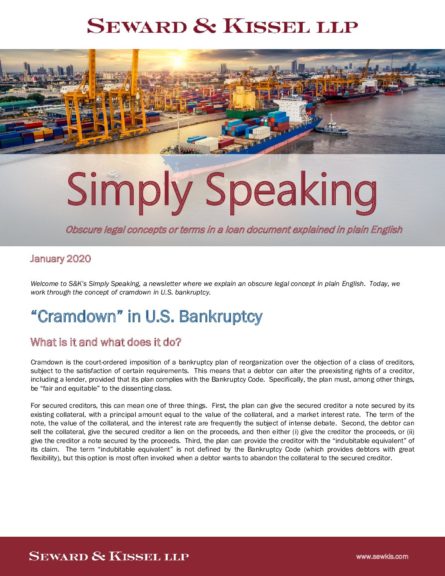
Simply Speaking (January 2020)
“Cramdown” in U.S. Bankruptcy
What is it and what does it do?
Cramdown is the court-ordered imposition of a bankruptcy plan of reorganization over the objection of a class of creditors, subject to the satisfaction of certain requirements. This means that a debtor can alter the preexisting rights of a creditor, including a lender, provided that its plan complies with the Bankruptcy Code. Specifically, the plan must, among other things, be “fair and equitable” to the dissenting class.
For secured creditors, this can mean one of three things. First, the plan can give the secured creditor a note secured by its existing collateral, with a principal amount equal to the value of the collateral, and a market interest rate. The term of the note, the value of the collateral, and the interest rate are frequently the subject of intense debate. Second, the debtor can sell the collateral, give the secured creditor a lien on the proceeds, and then either (i) give the creditor the proceeds, or (ii) give the creditor a note secured by the proceeds. Third, the plan can provide the creditor with the “indubitable equivalent” of its claim. The term “indubitable equivalent” is not defined by the Bankruptcy Code (which provides debtors with great flexibility), but this option is most often invoked when a debtor wants to abandon the collateral to the secured creditor.
Why is it there?
The underlying policy of the Bankruptcy Code is to provide a fresh start to the honest but unfortunate borrower. Cramdown furthers this policy by enabling a viable business to reorganize despite the objection of a debtor’s lender(s). The Code limits the circumstances under which cramdown can be achieved, attempting to strike a balance in enabling a borrower to restructure (by limiting a lender’s ability to hold out for better treatment) while preserving the contractual rights of lenders (by safeguarding against overreaching by borrowers).
Why is it important (or not so important) to lenders?
Understanding the cramdown process is critical to a secured creditor in any distressed scenario. The cramdown requirements, as set forth in the Bankruptcy Code, provide a framework for both pre-bankruptcy and post-bankruptcy negotiations with respect to the restructuring of a secured loan. If a lender has knowledge of the opportunities available to a debtor under the Code, it will have a good grasp of all potential outcomes and thus its options.
How does it affect borrower in practical terms?
Cramdown allows a borrower to effect a restructuring of its debts that it could not impose outside of bankruptcy. With respect to a secured creditor, this means that the borrower can modify interest rates, stretch out amortization periods, and remove covenants or make other arrangements. This is a significant tool in a distressed entity’s restructuring toolbox.
How is it relevant to shipping?
The traditional shipping capital structure typically includes several special purpose entities which each own a vessel (or a number of vessels) encumbered by financing. Toisa Limited, for example, included double digit lenders and loan facilities. With secured financing playing such an integral role in the shipping industry, the treatment of such credit in a prospective U.S. insolvency proceeding is important to understand. As most participants in the industry know, no matter how attenuated a company’s ties to the U.S. seem to be, there is a significant chance that company could utilize the protections of the Bankruptcy Code, including the cramdown provisions, leaving lenders with a loan substantially different than that which was originally contemplated.
Questions?
Please contact any member of S&K’s Restructuring and Maritime Practice Team.